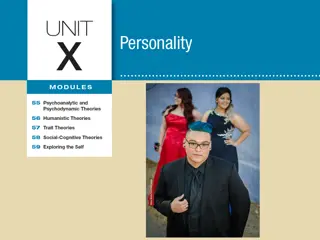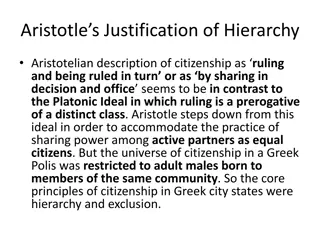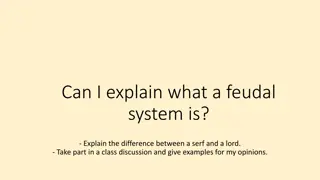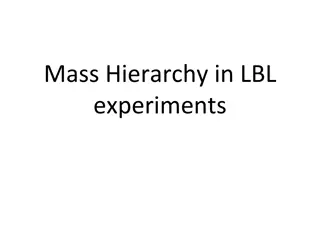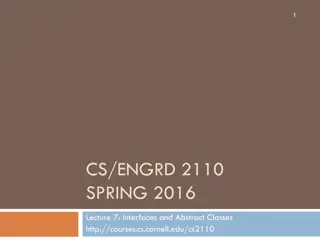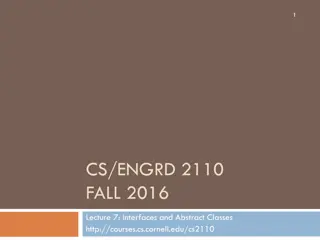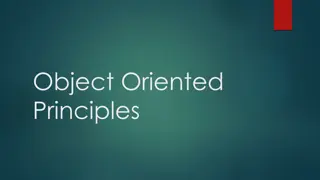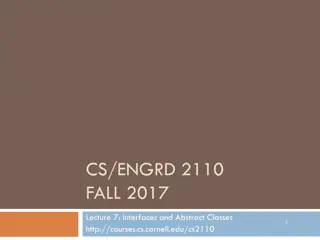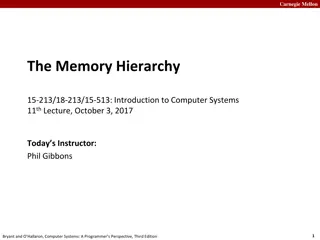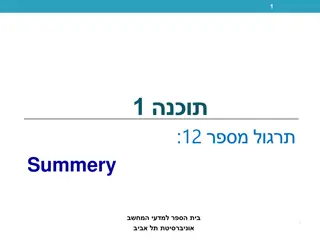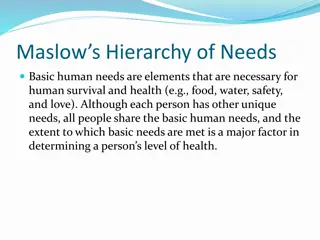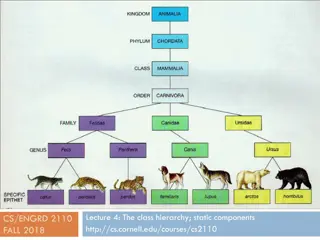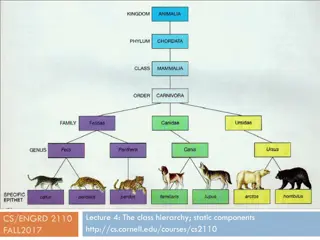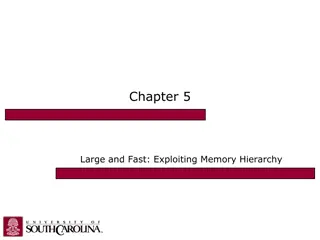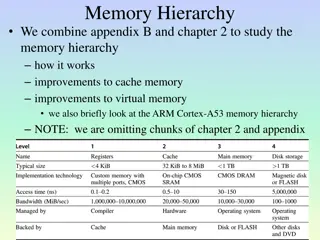Class Hierarchy in CS/ENGRD 2110: Lecture Highlights
In Lecture 4 of CS/ENGRD 2110, the focus was on understanding the class hierarchy and static components. The lecture covered topics such as forming study groups, working on assignments, testing methods, and Java applications. References to important texts and Java summaries were provided, along with guidance on homework assignments and test case development. The lecture emphasized the importance of understanding concepts like static components, method overriding, and the Object class. Students were encouraged to study code style guidelines and conventions for better programming practices.
Download Presentation

Please find below an Image/Link to download the presentation.
The content on the website is provided AS IS for your information and personal use only. It may not be sold, licensed, or shared on other websites without obtaining consent from the author.If you encounter any issues during the download, it is possible that the publisher has removed the file from their server.
You are allowed to download the files provided on this website for personal or commercial use, subject to the condition that they are used lawfully. All files are the property of their respective owners.
The content on the website is provided AS IS for your information and personal use only. It may not be sold, licensed, or shared on other websites without obtaining consent from the author.
E N D
Presentation Transcript
1 CS/ENGRD 2110 SPRING 2016 Lecture 4: The class hierarchy; static components http://courses.cs.cornell.edu/cs2110
Announcements 2 We're pleased with how many people are already working on A1, as evidenced by Piazza activity That pesky -ea flag! Please be sure to look at Piazza note @44 every day for frequently asked questions and answers Groups: Forming a group of two? Do it well before you submit at least one day before. Both members must act: one invites, the other accepts. Thereafter, only one member has to submit the files. A2: Practice with strings We will give you our test cases soon!
References to text and JavaSummary.pptx 3 A bit about testing and test cases Class Object, superest class of them all. Text: C.23 slide 30 Function toString() C.24 slide 31-33 Overriding a method C15 C16 slide 31-32 Static components (methods and fields) B.27 slide 21, 45 Java application: a program with a class that declares a method with this signature: public static void main(String[])
Homework 4 1. Read the text, about applications: Appendix A.1 A.3 2. Read the text, about the if-statement: A.38 A.40 3. Visit course website, click on Resources and then on Code Style Guidelines. Study 2. Format Conventions 4.5 About then-part and else-part of if-statement
A bit about testing 5 Test case: Set of input values, together with the expected output. Develop test cases for a method from its specification --- even before you write the method s body. /** returns the number of vowels in word w. Precondition: w contains at least one letter and nothing but letters */ publicint numberOfVowels(String w) { } Developing test cases first, in critique mode, can prevent wasted work How many vowels in each of these words? creek syzygy yellow and errors
Class W (for Worker) 6 /** Constructor: worker with last name n, SSN s, boss b (null if none). Prec: n not null, s in 0..999999999 with no leading zeros.*/ public W(String n, int s, W b) /** = worker's last name */ public String getLname() W@af lname Obama ssn 123456789 boss W /** = last 4 SSN digits */ public String getSsn() null /** = worker's boss (null if none) */ public W getBoss() W( ) getLname() getSsn() getBoss() setBoss(W) toString() equals(Object) hashCode() /** Set boss to b */ publicvoid setBoss(W b) Contains other methods!
Class Object: the superest class of them all 7 Java: Every class that does not extend another extends class Object. That is, We draw object like this W@af public classW { } Object toString() equals(Object) hashCode() is equivalent to W public class W extends Object { } lname Obama ssn 123456789 boss null We often omit this partition to reduce clutter; we know that it is always there. W( ) getLname() getSsn(), getBoss() setBoss(W)
A note on design 8 Don t use extends just to get access to hidden members! A should extend B if and only if A is a B A PhDTester is not a PhD Student! An elephant is an animal, so Elephant extends Animal A car is a vehicle, so Car extends Vehicle An instance of any class is an object, so AnyClass extends java.lang.Object The inheritance hierarchy should reflect modeling semantics, not implementational shortcuts
What is the name of the object? 9 The name of the object below is PhD@aa11bb24 It contains a pointer to the object i.e. its address in memory, and you can call it a pointer if you wish. But it contains more than that. Variable e, declared as PhD e; contains not the object but the name of the object (or a pointer to the object). PhD@aa11bb24 PhD name Mumsie ad1 null ad2 null e PhD@aa11bb24 PhD advisees 1
Method toString 10 toString() in Object returns the name of the object: W@af c W@af Java Convention: Define toString() in any class to return a representation of an object, giving info about the values in its fields. W@af Object toString() W New definitions of toString() override the definition in Object.toString() lname Obama ssn123456789 boss In appropriate places, the expression c automatically does c.toString() null getSsn() toString() c.toString() calls this method
Method toString 11 toString() in Object returns the name of the object: W@af c W@af public class W { W@af Object toString() /** Return a representation of this object */ public String toString() { return Worker + lname + has SSN ???-??- + getSsn() + (boss == null ? : and boss + boss.lname); } c.toString() calls this method W lname Obama ssn123456789 boss null getSsn() toString()
Another example of toString() 12 /** An instance represents a point (x, y) in the plane */ public class Point { privateint x; // x-coordinate privateint y; // y-coordinate /** = repr. of this point in form (x, y) */ public StringtoString() { return ( + x + , + y + ) ; } } Function toString should give the values in the fields in a format that makes sense for the class. Point@fa8 Point x y 9 5 (9, 5)
What about this 13 this keyword: this evaluates to the name of the object in which it occurs Makes it possible for an object to access its own name (or pointer) Example: Referencing a shadowed class field public class Point { public int x = 0; public int y = 0; //constructor public Point(int x, int y) { x = x; y = y; } } Inside-out rule shows that field x is inaccessible! public class Point { public int x = 0; public int y = 0; //constructor public Point(int x, int y) { this.x = x; this.y = y; } }
Intro to static components 14 /** = this object is c s boss . Pre: c is not null. */ publicboolean isBoss(W c) { return this == c.boss; } x.isBoss(y) is false y.isBoss(x) is true xW@b4 y W@af Spec: return the value of that true-false sentence. True if this object is c s boss, false otherwise W@b4 W@af W W lname bossW@af isBoss(W c) { return this == c.boss; } lname Om boss null Jo keyword this evaluates to the name of the object in which it appears isBoss(W c) { }
Intro to static components 15 Body doesn t refer to any field or method in the object. Why put method in object? /** = b is c s boss . Pre: b and c are not null. */ publicboolean isBoss(W b, W c) { return b == c.getBoss(); } xW@b4 y W@af W@b4 W@af W W lname bossW@af lname Om boss null Jo /** = this object is c s boss . Pre: c is not null. */ publicboolean isBoss(W c) { return this == c.boss; } ssn21 isBoss(W) isBoss(W,W) isBoss(W,W) ssn35 isBoss(W)
Intro to static components static: there is only one copy of the method. It is not in each object 16 /** = b is c s boss . Pre: b and c are not null. */ publicstaticboolean isBoss(W b, W c) { return b == c.getBoss(); } Box for W (objects, static components) W@b4 W@af x.isBoss(x, y) y.isBoss(x, y) W W lname bossW@af lname Om boss null Jo Preferred: W.isBoss(x, y) ssn21 isBoss(W) ssn35 isBoss(W) W@af xW@b4 y isBoss(W,W)
Good example of static methods 17 java.lang.Math http://docs.oracle.com/javase/8/docs/api/java/lang/Math.html
Java application 18 Java application: bunch of classes with at least one class that has this procedure: public static void main(String[] args) { } Type String[]: array of elements of type String. We will discuss later Running the application effectively calls method main Command line arguments can be entered with args
Use of static variables: Maintain info about created objects 19 public class W { privatestaticint numObs; // number of W objects created /** Constructor: */ publicW( ) { numObs= numObjs + 1; } W@bd W@12 W W } To have numObs contain the number of objects of class W that have been created, simply increment it in constructors. lname lname Bid Ob numObs 2 Box for W
Uses of static variables: Implement the Singleton pattern 20 Only one Singleton can ever exist. public class Singleton { private static final Singleton instance= new Singleton(); private Singleton() { } // ... constructor public static Singleton getInstance() { return instance; } Singleton@x3k3 Singleton // ... methods } instance Singleton@x3k3 Box for Singleton
Class java.awt.Color uses static variables 21 An instance of class Color describes a color in the RGB (Red-Green- Blue) color space. The class contains about 20 static variables, each of which is (i.e. contains a pointer to) a non-changeable Color object for a given color: public static final Color black = ; public static final Color blue = ; public static final Color cyan = new Color(0, 255, 255); public static final Color darkGray = ; public static final Color gray = ; public static final Color green = ;


